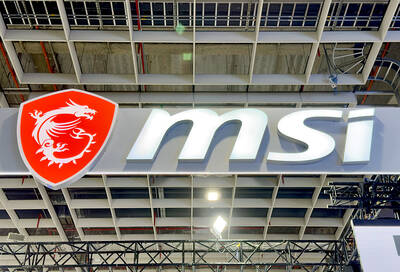Microsoft Corp said revenue growth in its cloud-computing business Azure would decelerate this quarter and warned of a further slowdown in corporate software sales, fueling concern about a steeper decline in demand for products that have driven its momentum in the past few years.
Shares erased earlier gains in late trading after Microsoft chief financial officer Amy Hood said Azure sales would this quarter slow by 4 or 5 percentage points from the end of the fiscal second quarter, when gains were at a mid-30s percentage.
That business had marked a bright spot in a lackluster earnings report for Microsoft, whose other divisions were held back by a slump in sales related to personal computer software and video games.

Photo: Bloomberg
Shareholders had earlier sent the stock up more than 4 percent, encouraged by signs of resilience in Microsoft’s cloud business even in a weaker overall market for software and other technology products.
The firm’s downbeat forecast brought the focus back to the software giant’s challenges as corporate customers hit the brakes on spending.
Revenue growth of 2 percent in the second quarter was the slowest in six years, and Microsoft last week said it is firing 10,000 workers.
Earlier on Tuesday, the company said adjusted profit in the quarter ended Dec. 31 was US$2.32 a share, while sales rose to US$52.7 billion.
That compared with average analysts’ projections for US$2.30 a share in earnings and US$52.9 billion in revenue, a Bloomberg survey showed.
Excluding currency impacts, Azure revenue gained 38 percent for the full quarter, slightly topping analyst predictions.
Microsoft said it recorded a charge of US$1.2 billion, or US$0.12 per share, in the latest quarter, with US$800 million of that related to the job cuts, which would affect fewer than 5 percent of its workforce.
The Redmond, Washington-based company last week said the charge would include severance, “changes to our hardware portfolio” and the cost of consolidating real-estate leases.
The company’s shares declined about 1 percent after executives gave their forecast on the conference call.
Earlier, they rose as high as US$254.79, after closing at US$242.04 in regular New York trading. The stock dropped 29 percent last year, compared with a 20 percent slide in the S&P500 index.
After years of double-digit percentage revenue gains fueled by Microsoft’s accelerating cloud business, and robust growth during the technology spending spree of the COVID-19 pandemic, CEO Satya Nadella said that the industry is going through a period of deceleration and would need to adjust.
“During the pandemic there was rapid acceleration. I think we’re going to go through a phase today where there is some amount of normalization in demand,” Nadella said in an interview at the World Economic Forum in Davos, Switzerland, earlier this month. “We will have to do more with less — we will have to show our own productivity gains with our own technology.”
Azure has been Microsoft’s most closely watched business for years, and has fueled a resurgence in revenue since Nadella took the helm in 2014 and oriented the company around the burgeoning cloud-computing market, in which it competes with Amazon.com Inc, Alphabet Inc’s Google and others.
Microsoft is turning to artificial intelligence applications to fuel more Azure demand.
Revenue from the Azure machine learning service has more than doubled for five quarters in a row, Nadella said.

Meta Platforms Inc offered US$100 million bonuses to OpenAI employees in an unsuccessful bid to poach the ChatGPT maker’s talent and strengthen its own generative artificial intelligence (AI) teams, OpenAI CEO Sam Altman has said. Facebook’s parent company — a competitor of OpenAI — also offered “giant” annual salaries exceeding US$100 million to OpenAI staffers, Altman said in an interview on the Uncapped with Jack Altman podcast released on Tuesday. “It is crazy,” Sam Altman told his brother Jack in the interview. “I’m really happy that at least so far none of our best people have decided to take them

BYPASSING CHINA TARIFFS: In the first five months of this year, Foxconn sent US$4.4bn of iPhones to the US from India, compared with US$3.7bn in the whole of last year Nearly all the iPhones exported by Foxconn Technology Group (富士康科技集團) from India went to the US between March and last month, customs data showed, far above last year’s average of 50 percent and a clear sign of Apple Inc’s efforts to bypass high US tariffs imposed on China. The numbers, being reported by Reuters for the first time, show that Apple has realigned its India exports to almost exclusively serve the US market, when previously the devices were more widely distributed to nations including the Netherlands and the Czech Republic. During March to last month, Foxconn, known as Hon Hai Precision Industry

PLANS: MSI is also planning to upgrade its service center in the Netherlands Micro-Star International Co (MSI, 微星) yesterday said it plans to set up a server assembly line at its Poland service center this year at the earliest. The computer and peripherals manufacturer expects that the new server assembly line would shorten transportation times in shipments to European countries, a company spokesperson told the Taipei Times by telephone. MSI manufactures motherboards, graphics cards, notebook computers, servers, optical storage devices and communication devices. The company operates plants in Taiwan and China, and runs a global network of service centers. The company is also considering upgrading its service center in the Netherlands into a

Taiwan’s property market is entering a freeze, with mortgage activity across the nation’s six largest cities plummeting in the first quarter, H&B Realty Co (住商不動產) said yesterday, citing mounting pressure on housing demand amid tighter lending rules and regulatory curbs. Mortgage applications in Taipei, New Taipei City, Taoyuan, Taichung, Tainan and Kaohsiung totaled 28,078 from January to March, a sharp 36.3 percent decline from 44,082 in the same period last year, the nation’s largest real-estate brokerage by franchise said, citing data from the Joint Credit Information Center (JCIC, 聯徵中心). “The simultaneous decline across all six cities reflects just how drastically the market